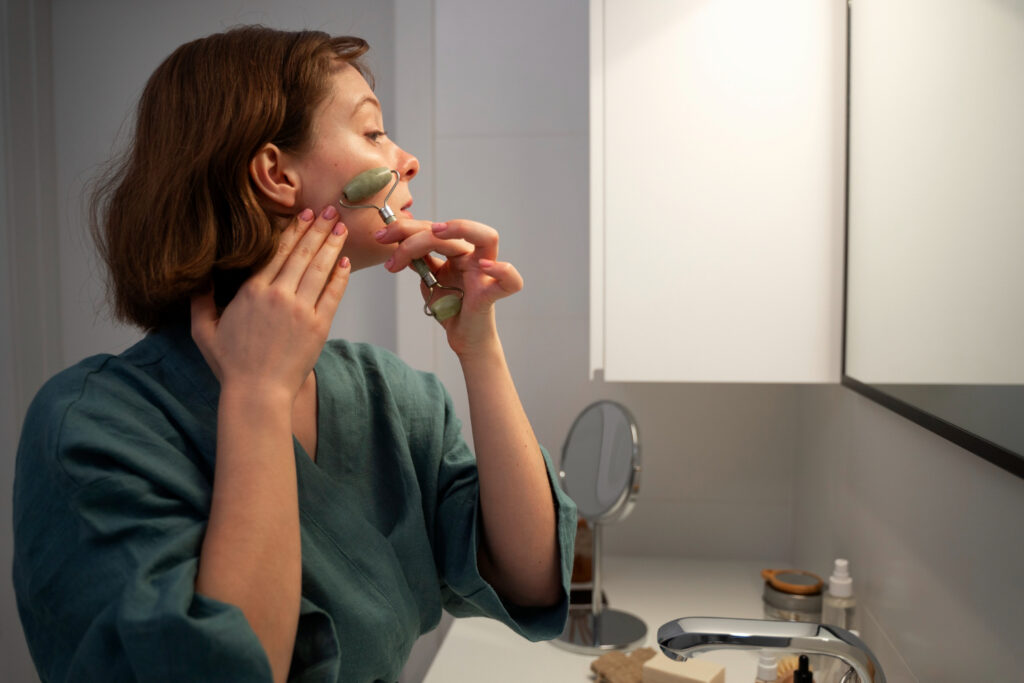Remember when skincare meant frantically scrubbing away makeup at midnight before collapsing into bed? Or perhaps that “skincare routine” was just a fancy face wash followed by whatever moisturizer was on sale? For many of us, our twenties were a time of skincare chaos—sometimes diligent, sometimes neglectful, but rarely consistent.
Then something shifts around 30. Maybe you notice the first fine lines that don’t disappear after a good night’s sleep. Perhaps your skin doesn’t bounce back from that all-nighter quite as quickly. Or maybe you simply realize that your skin deserves more thoughtful attention than a hasty bedtime cleanse.
Whatever your awakening moment, welcome to the transition where skincare evolves from a chore into something more intuitive—a natural rhythm that flows with your life rather than another box to check off your to-do list.
The Shift from Rules to Rhythm
“I used to be obsessed with following 10-step routines exactly as prescribed online,” shares Melissa, 34, a project manager from Boston. “It was exhausting, expensive, and honestly? My skin was constantly irritated because I wasn’t listening to what it actually needed day-to-day.”
This experience resonates with many women entering their thirties. The rigid routines that beauty influencers swear by often don’t account for one crucial factor: your skin is a living organ that changes daily, seasonally, and through different life phases.
Developing a skincare rhythm means tuning into these natural fluctuations rather than fighting against them. It’s about responding to what your skin is telling you today, not blindly following steps on a bathroom counter checklist.
Why Your Thirties Demand a Different Approach
Biologically speaking, our thirties bring subtle but significant changes to our skin:
- Cell turnover gradually slows down (meaning skin doesn’t renew itself quite as rapidly)
- Oil production often decreases, particularly for those who had oilier skin in their youth
- Collagen production naturally begins to decline
- Hormonal fluctuations may create new patterns and sensitivities
- Environmental exposure effects start becoming more visible
But perhaps most importantly, our thirties often coincide with significant life intensification—career advancement, family responsibilities, deeper relationships, and greater self-awareness all compete for our energy and attention.
“When I turned 30, my skincare priorities shifted,” explains Adrienne, 37, an attorney and mother of two. “I no longer had time for elaborate routines, but I also cared more about long-term results rather than quick fixes. I needed something sustainable that worked with my unpredictable life, not against it.”
Tuning Into Your Skin’s Natural Cadence
Finding your skincare rhythm begins with observation. Rather than imposing a rigid schedule, start by noticing patterns:
Morning Observations
- How does your skin feel when you first wake up? Tight, balanced, oily?
- Does your skin look different based on your sleep quality the night before?
- How does your skin respond to weather changes?
Evening Check-ins
- How does your skin feel at the end of the workday?
- Which days does your face feel particularly congested or dehydrated?
- What’s happening in your life when your skin looks its best?
Jenna, 32, a graphic designer from Chicago, created a simple skin journal that transformed her approach: “I started noting not just products, but also stress levels, diet changes, and even my menstrual cycle. Within two months, I could predict what my skin would need based on these patterns.”
The Four Rhythms of Intuitive Skincare
As you become more attuned to your skin’s natural fluctuations, you’ll likely discover several distinct rhythms that call for different approaches:
1. The Daily Baseline Rhythm
This forms the foundation of your skincare—the non-negotiable basics that your skin needs regardless of other factors:
- Morning cleansing (which might be just water or a gentle cleanser, depending on your skin type)
- Protection (sunscreen is non-negotiable, regardless of weather or season)
- Evening cleansing (to remove the day’s accumulated elements)
- Nightly nourishment (typically a moisturizer suited to your skin type)
Tasha, 36, found freedom in simplifying: “I used to have separate routines for morning and night with different products. Now I use the same gentle cleanser and moisturizer twice daily, adjusting only the weight of my moisturizer based on the season. The consistency has actually improved my skin tone more than all those specialty products ever did.”
2. The Cyclical Rhythm
Many women notice their skin changes predictably with their menstrual cycle. Understanding this pattern allows you to anticipate and prepare for these shifts:
- Pre-period: Many experience increased oil production and congestion
- During period: Skin often appears duller and may be more sensitive
- Post-period: A “golden week” where skin typically looks its best
- Mid-cycle: Often a balanced time with minimal issues
“I used to scramble to address breakouts when they appeared,” says Michelle, 33. “Now I know they’re coming about three days before my period, so I preemptively switch to a more clarifying cleanser for just that week, then return to my gentler products. Prevention instead of reaction.”
3. The Seasonal Rhythm
Your skin’s needs shift dramatically with the seasons, particularly if you live in a climate with distinct weather patterns:
- Winter typically calls for more hydration and barrier support
- Spring may bring environmental sensitivities as pollen counts rise
- Summer often requires lighter formulations but more sun protection
- Fall can be a time of repair and recovery after summer exposure
“I used to fight against seasonal changes,” admits Lauren, 38. “Now I embrace them. I store away my rich creams in summer just like I pack away my sweaters. My bathroom cabinet changes with the seasons, and my skin is so much happier for it.”
4. The Responsive Rhythm
Perhaps most importantly, developing a skincare rhythm means creating space for your skin’s changing needs:
- Stress, sleep deprivation, or illness may trigger sensitivity requiring a more gentle approach
- Travel to different climates calls for temporary adjustments
- Hormonal fluctuations might necessitate additional hydration or calming elements
- Celebration recoveries (yes, we’re talking about those special occasions when maybe one glass became three)
“I used to stick to my routine no matter what,” shares Elise, 35. “After a late night, I’d still use my active serums and wonder why my skin felt irritated. Now I listen—if my skin feels sensitive, I skip the actives and focus on gentle hydration. It’s about respecting what my skin is telling me, not bulldozing ahead with what I think it ‘should’ be ready for.”
The Art of Mindful Product Selection
With skincare rhythm established, product selection becomes more intuitive as well:
Core Products vs. Supporting Cast
Think of your skincare like a capsule wardrobe:
Core Products (Your Everyday Essentials)
- Gentle cleanser that never irritates, even on sensitive days
- Reliable moisturizer that works year-round (perhaps in different weights)
- Sunscreen that you genuinely enjoy applying (crucial for consistent use)
Supporting Cast (Rotate Based on Need)
- Hydrating serums for drier periods
- Clarifying products for congested phases
- Soothing elements for sensitive moments
- Targeted treatments for specific concerns
Alicia, 37, found this approach liberating: “I used to have 30+ products crammed into my bathroom. Now I have six that I truly understand and use regularly. My skin is clearer, my wallet is happier, and getting ready feels less overwhelming.”
The Power of Multi-Tasking Products
As life grows more complex in your thirties, the appeal of streamlined solutions increases. Products that serve multiple purposes not only save time but often deliver more consistent results because you’ll actually use them:
- Moisturizing sunscreens that provide both hydration and protection
- Overnight masks that both hydrate and gently exfoliate
- Cleansing balms that remove makeup while nourishing skin
“I’ve embraced the ‘less but better’ philosophy,” says Renee, 34. “My tinted moisturizer with SPF means three steps in one. It’s not about cutting corners—it’s about sustainability. The best skincare is the one you’ll actually maintain.”
Creating Rituals Within Your Rhythm
While the concept of skincare as rhythm emphasizes flexibility, establishing certain touchpoints as rituals can enhance both your skin’s health and your personal wellbeing:
The Sunday Reset
Many women find that a weekly “skin reset” helps maintain balance while creating a moment of self-connection:
“Sunday evenings are sacred,” explains Danielle, 36. “Kids are in bed, work emails can wait, and I take 30 minutes just for my skin. I do a gentle exfoliation, apply a mask while soaking in the tub, and then take my time with the rest of my routine. It’s preparation for the week ahead, but also a moment to check in with myself.”
The Seasonal Transition Ritual
The changing of seasons offers a natural opportunity to reassess and adjust:
“On the first day of each season, I take everything out of my bathroom cabinet,” shares Kayla, 33. “I evaluate what my skin will need for the coming months, put away products that won’t serve me, and make thoughtful additions if necessary. It keeps me from accumulating products I don’t need while ensuring my skin has what it requires.”
The Conscious Application Practice
Even daily application can become a mindful moment rather than a rushed task:
“I used to slap products on my face while mentally reviewing my to-do list,” admits Vivian, 38. “Now I take 30 seconds with each product to actually massage it into my skin, feeling the texture, noticing how my skin responds. It’s become a moment of presence in my day rather than another task to complete.”
When to Seek Professional Guidance
While developing an intuitive skincare rhythm empowers you to make daily decisions for your skin, certain situations warrant professional input:
- Persistent issues that don’t respond to your usual adjustments
- Sudden changes in skin behavior without obvious cause
- Development of sensitivity to previously tolerated ingredients
- Specific concerns about visible changes in moles or skin texture
“I became comfortable managing my skin’s daily fluctuations,” says Rachel, 39, “but when I developed unexpected redness that didn’t resolve within a few weeks, I consulted a dermatologist. The combination of my daily observations plus professional expertise led to a solution much faster than either approach alone could have.”
The Profound Freedom of Skin Rhythm
Perhaps the most beautiful aspect of shifting from rigid routines to natural rhythms is the freedom it creates—freedom from comparison, from product overload, and from the tyranny of “perfect skin” expectations.
“In my twenties, I was chasing someone else’s skin ideal,” reflects Sofia, 41. “Now I understand my skin’s unique patterns and needs. Some days it’s luminous, some days it’s tired, just like me. I’ve learned to support it rather than fight it, and we’ve found our harmony together.”
This evolution represents more than just a skincare philosophy—it’s a microcosm of how many women approach life differently after 30. We move from rigid expectations toward authentic rhythm, from external validation toward internal wisdom, from fighting our nature toward flowing with it.
Your skincare rhythm becomes not just about maintaining your skin, but about honoring the changing woman you are becoming, day by day, season by season, year by year.
Finding Your Own Rhythm: Starting Points
Ready to transition from routine to rhythm? These prompts can help you begin:
- Observe Without Judgment: For one week, simply note how your skin looks and feels each morning and evening without making any changes to your current approach.
- Identify Patterns: Review your observations to spot connections between your skin’s behavior and factors like stress, sleep, diet, weather, and hormonal fluctuations.
- Establish Your Non-Negotiables: Determine the absolute baseline your skin needs daily—typically cleansing, moisturizing, and sun protection.
- Create Flexible Categories: Rather than rigid steps, think in terms of functions your skin might need: hydration, calming, clarifying, protection, etc.
- Build Your Capsule Collection: Select versatile products that can address multiple needs rather than single-purpose solutions.
- Trust Your Intuition: Your skin will tell you what it needs if you listen—tightness calls for hydration, congestion might need gentle clarification, sensitivity requires a step back from active ingredients.
Remember that finding your rhythm takes time—it’s not about perfection but about progressively aligning with your skin’s natural flow. The harmony that develops is well worth the journey.

Disclaimer: This article is for informational purposes only and should not be construed as medical advice. The content reflects general principles of skincare and wellness but may not apply to everyone’s specific situation. Individual skin concerns should be addressed with qualified healthcare providers. The information provided is based on general knowledge about skin health and should not replace professional consultation for specific skin conditions or concerns.
Sources:
- American Academy of Dermatology
- International Journal of Women’s Dermatology
- Journal of Cosmetic Dermatology
- National Institute on Aging



